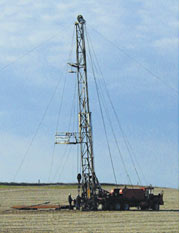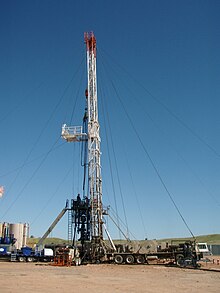Working up (drilling)

Under workover (English: workover) is understood in the deep drilling to maintain, improve or restore the capacity of crude oil and natural gas or groundwater in a borehole or well by invasive procedures. To do this, tools are inserted into the borehole to be overcome using a cable winch ( slickline ), a rolled-up flexible steel pipe ( coiled tubing ) or rods ( snubbing ).
Reasons for a bother
Boreholes have to be dealt with if, for example, wellhead components, the production pipe, the pipe tour or underground system components such as submersible pumps , packers or valves in the borehole have to be repaired or replaced. This may be necessary because of stress , corrosion or damage or to use more powerful components.
If the pipe route or the perforation are impaired by deposits , mechanical removal of these deposits using special brushes or scrapers is often necessary ( broaching ).
Even if the pressure conditions change as a result of the exploitation of the reservoir , one speaks of overwork when the borehole diameter is reduced by installing a leaner pipe section in order to maintain the production pressure. Likewise, new perforations or sealing of the borehole wall as well as deepening of the boreholes are work-out work.
execution
Before the workover work can begin, the well must be pumped to death . The borehole is filled with a high- density drilling fluid to counteract the overpressure in the formation and thus prevent blowouts .
When the borehole is secured against artesian eruptions, the blowout preventer or the eruption cross at the borehole head can be removed and the production probe with all underground system parts such as feed pumps, pump valves, pull-out packers, etc. can be removed and permanent packers milled out.
Then important borehole parameters can be measured (logging) and the borehole cleaned if necessary. Deposits such as calcium carbonate can be removed mechanically using a scraper, brush or high-pressure cleaner , and chemically using acids or solvents .
If necessary, the pipe tour can also be pulled, changed and re- cemented , but this is not always economical.
When the work has been completed and all components have been reinstalled or replaced, the mud can be circulated out of the borehole again, so that the gases or fluids can again escape from the rock formation into the borehole.
See also
literature
- Schlumberger oilfield glossary ; accessed on June 15, 2016
- Gunther Dette (Ed.): Lexicon of Gas Technology , 4th edition. Vulkan-Verlag, Essen 1996, 532 pp.
- World Energy Conference (Ed.): Energy Terminology: A Multi-Lingual Glossary . Elsevier, Amsterdam 2013, 564 pp.
- WEG (Ed.): Technical rule: Borehole control - drilling, workover, well intervention . 2015, p. 7, PDF 5.16 MB; accessed on June 15, 2016


